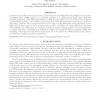Free Online Productivity Tools
i2Speak
i2Symbol
i2OCR
iTex2Img
iWeb2Print
iWeb2Shot
i2Type
iPdf2Split
iPdf2Merge
i2Bopomofo
i2Arabic
i2Style
i2Image
i2PDF
iLatex2Rtf
Sci2ools
MEDIAFORENSICS
2010
2010
On the embedding capacity of DNA strands under substitution, insertion, and deletion mutations
A number of methods have been proposed over the last decade for embedding information within deoxyribonucleic acid (DNA). Since a DNA sequence is conceptually equivalent to a unidimensional digital signal, DNA data embedding (diversely called DNA watermarking or DNA steganography) can be seen either as a traditional communications problem or as an instance of communications with side information at the encoder, similar to data hiding. These two cases correspond to the use of noncoding or coding DNA hosts, which, respectively, denote DNA segments that cannot or can be translated into proteins. A limitation of existing DNA data embedding methods is that none of them have been designed according to optimal coding principles. It is not possible either to evaluate how close to optimality these methods are without determining the Shannon capacity of DNA data embedding. This is the main topic studied in this paper, where we consider that DNA sequences may be subject to substitution, insertio...
| Added | 29 Jan 2011 |
| Updated | 29 Jan 2011 |
| Type | Journal |
| Year | 2010 |
| Where | MEDIAFORENSICS |
| Authors | Félix Balado |
Comments (0)

